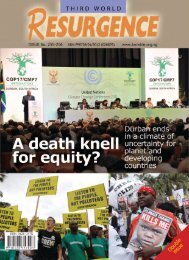Plantations, poverty and power - Critical Information Collective
Plantations, poverty and power - Critical Information Collective
Plantations, poverty and power - Critical Information Collective
Create successful ePaper yourself
Turn your PDF publications into a flip-book with our unique Google optimized e-Paper software.
90<br />
availability of wood,” Verkerk said, with a straight face.460 Conversely, if the forest is less well<br />
protected, the industry would have a lot more wood available. Verkerk made no mention of what the<br />
impact of this might be on the biodiversity of the forests.<br />
CEPI has various sub-groups which focus on supporting the interests of specific types of paper<br />
production. CEPIPRINT is the Association of European Publication Paper Producers. CEPIFINE<br />
represents Europe’s fine paper producers. CEPI Eurokraft looks after the interests of Europe’s paper sack<br />
manufacturers.<br />
Each of these groups produces material supporting the consumption of ever more paper. CEPI Eurokraft,<br />
for example, has produced a series of reports on the benefits of kraft paper packaging. A CEPI Eurokraft<br />
report produced between 1998 <strong>and</strong> 2000, for example, looked at a life-cycle analysis of paper sacks. Not<br />
surprisingly, CEPI Eurokraft concluded that paper sacks are more environmentally friendly that plastic<br />
sacks:<br />
“When comparing the paper sack <strong>and</strong> plastic sack systems with each other (<strong>and</strong> comparing all the waste<br />
treatment scenarios) the paper sack systems use less primary energy <strong>and</strong> contribute less to depletion of<br />
non-renewable resources <strong>and</strong> photochemical oxidant creation than the LDPE [low density polyethylene]<br />
sack systems.”461<br />
But CEPI Eurokraft could only come to this conclusion by ignoring the findings of the report that it<br />
commissioned to compare the various options. CEPI Eurokraft commissioned Chalmers Industriteknik in<br />
Sweden to compare four options for delivering animal feed: paper sacks; plastic sacks; semi-bulk plastic<br />
sacks; <strong>and</strong> transporting in bulk. What Chalmers Industriteknik found in its study was that the best system<br />
for transporting animal feed was the semi-bulk option, using large, reusable, woven polypropylene sacks:<br />
“The results of the study indicate that semi-bulk system gives the lowest contribution to all of the studied<br />
impact categories, at least in the base case where the big bags are assumed to be used on average three<br />
times.”462<br />
The Chalmers Industriteknik report notes that the more often the plastic sacks are reused, the better the<br />
system is for the environment, compared to paper sacks. I am not recommending the use of more plastic<br />
bags. I am simply pointing out that CEPI Eurokraft distorted the findings of the report that it<br />
commissioned, in order to suit its own ends.<br />
The report found that the impact of distributing the animal feed is far higher than the packaging used:<br />
“When including the distribution of the filling goods, the largest environmental profits are probably<br />
achieved through making the distribution as efficient as possible <strong>and</strong> through using the least harmful<br />
transportation modes (e.g. train) <strong>and</strong> fuels rather than through the choice of packaging system.”463<br />
460 The quotations of presenters at the side event are from my notes taken during the side event.<br />
461 “LCA of Distribution in Paper Sacks. Executive Summary”, Eurosac <strong>and</strong> CEPI Eurokraft, 2000, page 11.<br />
462 Anna Ryberg, Tomas Ekvall <strong>and</strong> Lisa Person (2000) ”Life Cycle Assessment of distribution in four different<br />
distribution systems in Europe. Third party report”, Chalmers Industriteknik, October 2000, page 4.<br />
463 Anna Ryberg, Tomas Ekvall <strong>and</strong> Lisa Person (2000) ”Life Cycle Assessment of distribution in four different<br />
distribution systems in Europe. Third party report”, Chalmers Industriteknik, October 2000, page 4.















